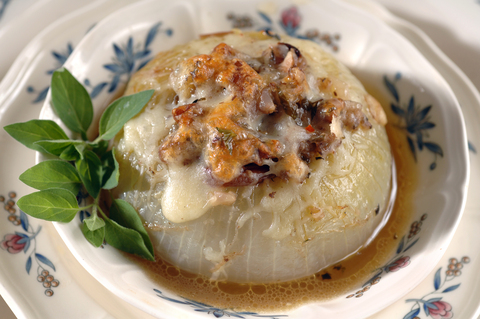
No one who has spent more than five minutes in an American kitchen needs to be retold the story of Vidalia Sweet Onions. Most of us know how a low sulfur content in the soil and warm, damp growing season conspired to produce an unusually sweet, moisture-rich bulb that became one of the earliest regional American food products to be protected by law.
What you may not know is that because they’re so juicy, they mold and rot more easily than other onions and therefore don’t keep as well. Even with the new cold storage technology that has extended their season into autumn and early winter, remain a seasonal delicacy. It also means that Vidalia onions can’t simply be substituted for convention yellow or white onions without taking steps to deal with all that the extra moisture.
Diced Vidalia and other sweet onion don’t sauté quite as well as other varieties and often take more heat and time to caramelize. Otherwise, they merely steam in their own juices. Rather than find ways to get around the extra moisture, I use generally regular yellow and white onions for routine cooking, and reserve sweet onions for things in which their juiciness is an advantage.
One especially lovely way to use them is in stuffing, where we want extra moisture anyway, or as a self-basting receptacle to hold the stuffing. Stuffed onions are of course nothing new, but Vidalia sweet onions are especially nice prepared this way because their extra juices make them naturally self-basting and their sweetness provides a perfect foil for spicy fillings.
Baked Vidalia Sweet Onions with Sausage and Pecans
You might follow the lead of Savannah’s legendary Chef Elizabeth Terry and serve these as an elegant first course as she once did at Elizabeth on 37th, but I like them as a simple main dish for a luncheon or family supper.
Serves 4
4 large Vidalia Sweet onions, left whole and unpeeled
½ pound bulk breakfast sausage
½ cup soft breadcrumbs
½ cup chopped toasted pecans
1 tablespoon chopped fresh, or 1 teaspoon dried, marjoram
1 tablespoon chopped fresh parsley
1 tablespoon chopped fresh, or 1 teaspoon dried, sage
Salt and whole black pepper in a peppermill
Whole nutmeg in a grater
½ cup freshly grated Gruyere or sharp cheddar
1. Position a rack in the center of the oven and preheat it to 375° F. Put the onions in a large pot and add enough water to cover them. Remove the onions, cover, and bring it to a boil over high heat. Add a small handful of salt and put in the onions. Let it come back to a boil, reduce the heat to low and simmer until the onions are almost but not quite done, about 20 minutes. Drain, reserving about a cup of their cooking liquid, and let them cool enough to handle.
2. Trim off the roots, leaving all the layers attached, and cut off about ¼ inch of the stem end. Peel off the brown outer skin. With a melon-baller or sharp spoon, carefully scoop out the centers without breaking the root ends, leaving 3-layer thick shells. Lightly butter a 9-inch square baking dish and put in the onions root side down. Chop the scooped-out centers.
3. Warm a skillet over medium heat and crumble in the sausage. Sauté, stirring often, until well browned, about 5 minutes. Add the chopped onion centers. Sauté until the onions are beginning to color, about 4 minutes more. Turn off the heat.
4. Add the soft crumbs, pecans, marjoram, parsley, and sage. Toss well, taste, and season with salt, pepper and nutmeg. Spoon the filling into the onion shells, mounding it on top. Sprinkle the tops evenly with grated cheese.
5. Carefully pour around them enough reserved cooking liquid to come about ¼-inch up the sides. Bake in the center of the oven until the cheese is golden brown and the filling is hot through, about 40 minutes. Let stand for a few minutes to allow the intense heat to subside, and serve hot or warm, basting each serving with pan juices. I like to serve them in shallow bowls with those pan juices—you won’t want to waste them.